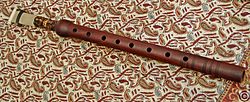Balaban (instrument)

Azerbaijani folk instrument Balaban.
|
|
| Classification | Woodwind |
|---|---|
| Playing range | |
| Musicians | |
| Alihan Samedov | |
Balaban, or balaman (Azerbaijani: Balaban) is cylindrical-bore, double-reed wind instrument about 35 centimetres (14 in) long with eight finger holes and one thumb hole. Balaban, one of the ancient wind instruments, is played in all corners of Azerbaijan. This instrument is played in Iranian Azerbaijan and in the Republic of Azerbaijan. In Turkey it is called mey. The Armenian Duduk looks very similar to it, but sounds a little different.
Balaban can be made of mulberry or other harder woods, such as walnut.The bore through the instrument is about 1.5 centimetres (0.59 in) in diameter. The double reed is made out of a single tube of cane about six cm long and pressed flat at one end. The performer uses air stored in his cheeks to keep playing the balaban while he inhales air into his lungs. This “circular” breathing technique is commonly used with all the double-reed instruments in the Middle East.
Balaban, which is often called also yasti (flat) balaban for flat mouthpiece and soft sound, consists of body made of apricot tree, cane, barrow and cover. Body has 8 holes on the surface and 1 on the back in the middle of 1st and 2nd holes (sound fret) on the surface.It consists of a stem, a reed, a regulator, and a cap.
The stem of the balaban, or govda, is a 280–320 millimetres (11–13 in) cylindrical tube made primarily of apricot wood (sometimes also hazel, pear, mulberry, boxwood, etc.). The process of carving a balaban stem is called balaban chakma. The upper end of the stem (bash or kup) is given a round shape, whereas the lower end (ayag) is sharpened. The bore is 10 millimetres (0.39 in) in diameter. Eight holes or "tones" constituting a "sound tone" (sas pardasi) are made on the obverse and another one is made on the bottom side, opposite of the interval between the first and the second holes of the sas pardasi. Sometimes an additional hole called nizam pardasi is made on the lower end of the bottom side to ensure good timbre.
...
Wikipedia

